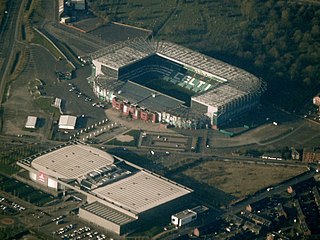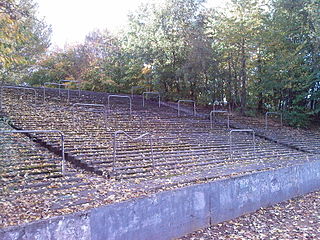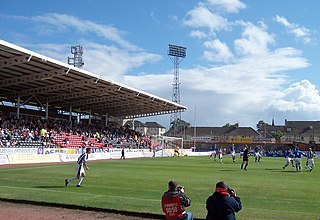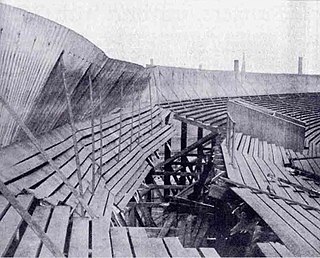
Rangers Football Club is a professional football club in Glasgow, Scotland. The team competes in the Scottish Premiership, the top division of Scottish football. The club is often referred to as Glasgow Rangers, though this has never been its official name. The fourth-oldest football club in Scotland, Rangers was founded by four teenage boys as they walked through West End Park in March 1872 where they discussed the idea of forming a football club, and played its first match against the now defunct Callander at the Fleshers' Haugh area of Glasgow Green in May of the same year. Rangers' home ground, Ibrox Stadium, designed by stadium architect Archibald Leitch and opened in 1929, is a Category B listed building and the third-largest football stadium in Scotland. The club has always played in royal blue shirts.

Celtic Park is a football stadium and the home of Scottish Premiership team Celtic Football Club, in the Parkhead area of Glasgow, Scotland. With a capacity of 60,832, it is the largest football stadium in Scotland, and the eighth-largest stadium in the United Kingdom. It is also known as Parkhead or Paradise.

Ibrox Stadium is a football stadium on the south side of the River Clyde in the Ibrox area of Glasgow, Scotland. The home of Scottish Premiership team Rangers, Ibrox is the third largest football stadium in Scotland, with an all-seated capacity of 51,700. The stadium was designed by renowned football stadium architect Archibald Leitch, with renovations to the stadium between 1978 and 1981, as well as 1990 and 1991, being designed by The Miller Partnership and Gareth Hutchison respectively.

Hampden Park is a football stadium in the Mount Florida area of Glasgow, Scotland, which is the national stadium of football in Scotland and home of the Scotland national football team. Hampden Park is owned by the Scottish Football Association (SFA), and regularly hosts the latter stages of the Scottish Cup and Scottish League Cup. The largest stadium by capacity when opened in 1903, an accolade the stadium held until 1950, Hampden Park is the 50th largest football stadium in Europe, the 11th largest in the United Kingdom, and the second largest football stadium in Scotland. The stadium retains all attendance records recorded in European football.

Cathkin Park is a municipal park in Glasgow, Scotland. The park is maintained by the city's parks department, and it is a public place where football is still played. The park contains the site of the second Hampden Park, previously home to the football clubs Queen's Park and Third Lanark. The site of the original Hampden Park is just to the west.
The Excelsior Stadium is a football stadium in Airdrie, North Lanarkshire, Scotland. It is the home ground of Airdrieonians of the Scottish Professional Football League (SPFL). Since the 2021–22 season it has also been used by Celtic for the home matches of their women's team in the Scottish Women's Premier League (SWPL) and B team in the Scottish Lowland Football League, as well as by Glasgow University F.C. of the West of Scotland Football League. It is an all-seater stadium with a capacity of 10,101, and has a 3G artificial surface.

St Mirren Park, more commonly known as Love Street, was a football stadium located on Love Street in Paisley, Scotland. At one time the stadium was capable of accommodating almost 50,000 spectators, however in its final years it had an all-seated capacity of 10,800. Until its closure in 2009, it was the home ground of St Mirren F.C.

Hampden Park in Glasgow is the primary home stadium for the Scotland national football team. This has been the case since 1906, soon after it opened. The present site of Hampden Park is the third location to bear that name and both the previous locations also hosted Scotland games. Scotland have also played many of their home games in other stadiums throughout their history, both in friendly matches and for competitive tournaments.

Linthouse Football Club was a football club from the Linthouse district of Govan, Scotland. The club played in navy blue.
The 1927–28 Scottish Cup was the 50th staging of Scotland's most prestigious football knockout competition. The Cup was won by Rangers who defeated Celtic 4–0 in an Old Firm final; it was their first victory in the competition for 25 years – the last had been in 1903, with four defeats in finals since then.
The 1904–05 Scottish Division One season was won by Celtic. Celtic and Rangers had finished the league campaign level on 41 points, and a play-off at Hampden Park was arranged to decide the championship. An English-based referee was drafted in to officiate at the match due to increasing tensions between the two groups of supporters and controversies in recent matches between the sides. Celtic won 2–1, with Jimmy McMenemy and Davie Hamilton scoring the decisive goals.

The 1902 Ibrox disaster was the collapse of a stand at Ibrox Park in Govan, Scotland. The incident led to the deaths of 25 supporters and injuries to 500 more during an international association football match between Scotland and England on 5 April 1902 as part of the 1901–02 British Home Championship.
The Football World Championship, also known as the United Kingdom Championship or the International Club Championship, was an exhibition association football match played between the English and Scottish club champions on a regular, but not annual, basis in the late 19th and early 20th centuries, with varying degrees of press attention and public interest. Perhaps the most widely publicised at the time under the 'World Championship' name was the 1888 event between Renton and West Bromwich Albion, while in the modern age interest from historians has drawn more attention to matches involving Sunderland, particularly the 1895 match. The FA Cup and Scottish Cup were qualification of the tournament.
Braehead Park, originally known as Hibernian Park, was a football ground in the Oatlands area of Glasgow, Scotland. It was the home ground of Glasgow Hibernian from 1889 until 1890, then used by Thistle from 1892 until they folded in 1895.
Cathkin Park was a football ground in the Crosshill area of Glasgow, Scotland. It was the home ground of Third Lanark from their foundation in 1872 until they moved to New Cathkin Park in 1903. It also hosted Scottish Cup final matches and the Scotland national team.
Meadowside was a football ground in the Partick area of Glasgow, Scotland. It was the home ground of Partick Thistle from 1897 until 1908.
New Logie Green was a football ground in the Powderhall area of Edinburgh, Scotland. It was the home ground of St Bernard's from 1889 until 1899, and was also used to host the 1896 Scottish Cup final, the only time the Scottish Cup final has been played outside Glasgow. The ground was named after a nearby mansion.
Celtic Park was a football ground in Glasgow, Scotland. It was the home ground of Celtic from 1888 until they moved to the site of the modern Celtic Park in 1892. The ground staged an international match between Scotland and Ireland in 1891.
Kinning Park was a 19th-century sports ground in Kinning Park, Renfrewshire, Scotland, primarily used for cricket and football. It was the home of Clydesdale Cricket Club from 1849, staging a number of important matches against visiting English teams. It was also the original home of the club's football team, Clydesdale F.C. When both teams relocated to Titwood in 1876, Kinning Park was taken over by Rangers F.C., who played there until moving to the first Ibrox Park in 1887. The ground was the venue for the 1881 Scottish Cup Final between Queen's Park and Dumbarton.
The Original Glasgow derby is the name for the old rivalry between crosstown Scottish football clubs Queen's Park and Rangers, both based in Glasgow. The two clubs are two of the most successful in the Scottish Cup, and the rivalry between them was one of the more intense in the early years of Scottish football, before being overtaken by the Old Firm rivalry from the 1900s onwards. The highest Scottish Cup attendance figure for the fixture was recorded on 18 January 1930 at Hampden Park for the first round, when 95,722 fans attended. The two clubs met in the top flight for last time during 1957–58, the final season before Queen's Park's relegation. The club retained their amateur status from their foundation in 1867 until 2019, which meant it was extremely difficult to compete at the highest level and the intensity of the derby dramatically declined after 1958 as the Spiders never returned to the top tier.









